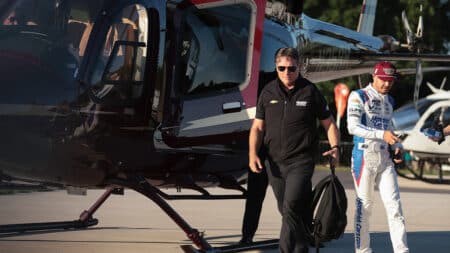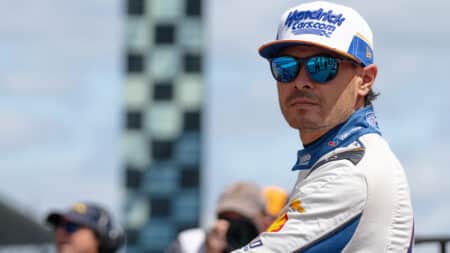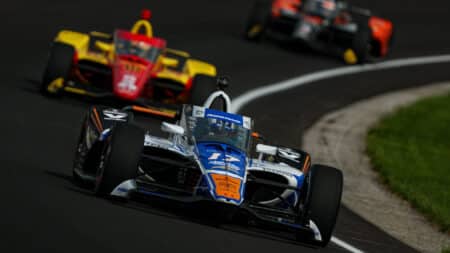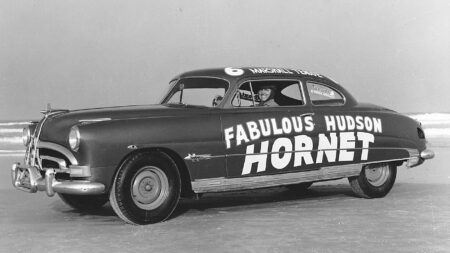Rain caused a six-and-a-half hour delay to this year’s Daytona 500 but when the chequered flag finally waved at 11.30 on Sunday evening ‘NASCAR Nation’ couldn’t have been happier. That’s because NASCAR’s most popular driver Dale Earnhardt Jr came through to control the closing laps and score his first win in 56 starts. It was Earnhardt’s second win and his first in 10 years in NASCAR’s biggest race as Hendrick Motorsport scored its fifth Daytona 500 victory.

“Winning this race is the greatest feeling you can feel in this sport, aside from accepting the champion’s trophy,” Earnhardt said. “I didn’t know if I’d get a chance to feel that again and it feels just as good if not better than the first because we tried so hard year after year and ran second all those years.
“This race car was awesome,” Earnhardt added. “We showed ‘em all night long how good a car we had. We battled all night and got a little help from Jeff [Gordon] on the last restart.”
Second place was taken by Denny Hamlin who enjoyed a great week in Daytona with his Joe Gibbs Toyota. Hamlin won the Sprint Unlimited the previous weekend and also won his 150-mile qualifying race on Thursday but struggled at the end of the 500 after his radio failed so he had to drive without the aid of his ‘spotter’.
Brad Keselowski finished third in one of Roger Penske’s Fords followed by Jeff Gordon and defending NASCAR champion Jimmie Johnson in two more Hendrick Chevrolets. “To have three Hendrick cars in the top five is just spectacular,” Gordon grinned. “It was unbelievable racing there at the end – two and three-wide, bump drafting and craziness.

Gordon (24) gives Earnhardt a push
“I was just hanging on trying not to wreck. I gave Jr a great push when we got the final green and then Jimmie gave me a huge push which helped me get fourth place.”
Daytona 500 Top 10
1 Dale Earnhardt Jr (Hendrick Chevrolet)
2 Denny Hamlin (Gibbs Toyota)
3 Jeff Gordon (Hendrick Chevrolet)
4 Brad Keselowski (Penske Ford)
5 Jimmie Johnson (Hendrick Chevrolet)
6 Ricky Stenhouse Jr (Roush Fenway Ford)
7 Matt Kenseth (Gibbs Toyota)
8 Greg Biffle (Roush Fenway Ford)
9 Austin Dillon (Childress Chevrolet)
10 Casey Mears (Germain Chevrolet)
NASCAR’s new championship format
Daytona’s restrictor plate racing with horsepower cut almost in half compared to most other NASCAR races means the 500 rarely provides much insight into the season to follow. That might be truer than ever this year after NASCAR’s chairman and CEO Brian France last month announced the fourth change in the past 11 years to the Sprint Cup championship methodology.
This year, 16 drivers – four more than in recent years – will take part in the ‘Chase for the Cup’ over the year’s final 10 races. Those 16 will be whittled down to four for the final race of the season making it all but impossible to predict who will win this year’s Sprint Cup title.
France says NASCAR is listening to its fans and responding to what they want as well as adapting to the changing requirements of the highly-competitive American sports market. NASCAR hopes to attract a broader audience with this change and most importantly add some spark to the flat line in TV ratings in recent years over the course of the ‘Chase of the Cup’.

Whatever you think about NASCAR’s eternal pursuit of showmanship a walk through the garages at Daytona last week would have made the organisation’s strengths clear to the most sceptical eye. The Sprint Cup garage was occupied by 23 teams fielding 47 cars with a slightly smaller but equally strong collection of Nationwide and Truck teams gathered elsewhere in separate, nearby garage areas.
NASCAR’s premier division enjoys a committed core group of 14 teams running two or more cars and most of these teams enjoy strong sponsorship. Three of the multi-car Sprint Cup teams run four cars with four more of them fielding three cars and a further seven running two cars.
All three of the four-car teams are Chevrolet operations led by Hendrick Motorsport with Johnson, Gordon, Earnhardt Jr and Kasey Kahne. NASCAR’s two other super teams are Stewart-Haas with Tony Stewart, Kevin Harvick, Kurt Busch and Danica Patrick; and Richard Childress Racing with Austin Dillon, Ryan Newman, Paul Menard and Brian Scott.
Most potent of the three-car teams are Joe Gibbs’s Toyota team and Roush-Fenway’s trio of Fords. Matt Kenseth, Kyle Busch and Denny Hamlin drive Gibbs’s Toyotas with Carl Edwards, Greg Biffle and Ricky Stenhouse Jr aboard Jack Roush’s Fords.

Strongest of the two-car teams is Team Penske with 2012 champion Brad Keselowski and Joey Logano driving a pair of Fords. And when you add the likes of Richard Petty Motorsports’ pair of Fords, Michael Waltrip’s trio of Toyotas, Chip Ganassi’s pair of Chevrolets and the Wood Brothers’ lone Ford, it’s hard to refute the contention that NASCAR enjoys a deeper, stronger field than any other form of racing on the planet.
Another measure of NASCAR’s health is the strong group of eight rookies, all between the age of 21 and 27, who are competing in this year’s Sprint Cup series. Kyle Larson, 21, replaces Juan Pablo Montoya this year in Ganassi’s #42 Target car, and Austin Dillon, 23, qualified on the pole for this year’s Daytona 500.
All eight rookies – seven of them qualified for the 500 – earned their rides from achieving success in NASCAR’s ladder system or the Midwestern ARCA series. Dillon is last year’s Nationwide champion and drives his grandfather Richard Childress’s #3 Chevrolet in his rookie Sprint Cup season. This is the first time the #3 has been used in NASCAR’s premier division since seven-time champion Dale Earnhardt died on the last lap of the 2001 Daytona 500 at the wheel of one of Childress’s cars.
More from Gordon Kirby
The career of Mark Donohue
American greats: Milton, Murphy and Lockhart
Daytona 24 Hours aftermath









